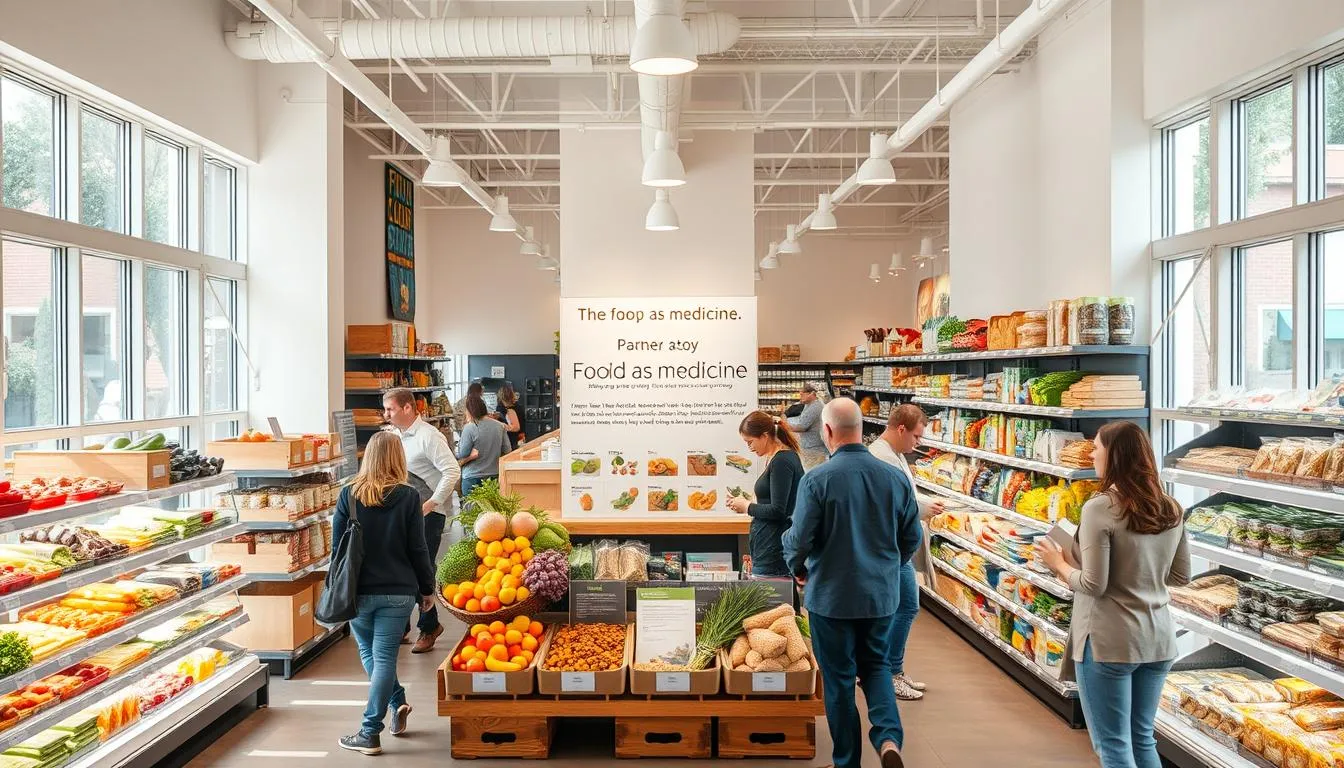I remember standing in an aisle wondering which choice might make tomorrow easier for my mom’s health. That moment stayed with me and shapes how I shop and think about care today.
Retailers and suppliers are turning stores into practical health hubs. A new FMI report and survey show 70% now have nutrition, health, and well‑being strategies. Many prioritize disease prevention and health promotion over the next two years.
Shoppers will see clear solutions in-store: nutrition labeling, cooking demos, signage, and targeted promotions. Companies deploy clinical staff—82% use registered dietitians, and many now add RNs, NPs, and MDs to guide people toward realistic wellness choices. Consider exploring healthier food substitutions and protein-rich snack options to maximize nutritional benefits.
This movement is evidence-driven and collaborative. Cross-industry partnerships and incentives help translate research into on-aisle programs that support better habits without guilt or confusion.
Key Takeaways
- Industry momentum: major retailers invest in nutrition and health strategies backed by an FMI report.
- In-store features: labeling, demos, displays, and advertisement drive clearer choices.
- Clinical support: dietitians and clinicians are working inside stores to offer practical guidance.
- Programs are measurable: prevention, tailored meals, and prescription pilots are growing.
- Collaboration matters: partnerships with insurers and health groups scale solutions for people.
Inside the food‑as‑medicine grocery movement: how grocers became partners in health
The retail shelf is becoming a practical extension of community health programs. Retailers and suppliers now treat stores as touchpoints for prevention and daily support.

From buzzword to store aisle: defining “food is medicine” in today’s grocery landscape
In plain terms, this movement links food, health and medicine so shoppers can access diet-forward supports inside familiar retail settings.
That means clearer labeling, in-store education, and services that guide choices without overwhelming people.
Why now: momentum, bipartisan attention, and investment
Pressure from research is a big driver: poor diet is tied to 45% of U.S. cardiometabolic deaths and 70% of new diabetes cases worldwide.
Federal focus and high-dollar commitments from groups like The Rockefeller Foundation and the American Heart Association have pushed pilots into broader strategies.
| Driver | What retailers do | Expected effect |
|---|---|---|
| Research & data | Evidence-based labeling and programs | Better preventive outcomes |
| Funding & initiatives | Pilot scaling and partnerships | More consistent access |
| Industry strategy | Clinical staff and store activations | Practical shopper guidance |
“Most retailers now have formal health strategies and are activating across store environments.”
- Organizations and companies collaborate to standardize helpful practices.
- Prevention is the core theme: early, affordable interventions in everyday places.
Evidence on the shelf: medically tailored programs and produce prescriptions driving outcomes
Clinical pilots are turning clinic referrals into home pantries stocked for prevention. Evidence now shows targeted nutrition supports can reduce risk and improve biomarkers when paired with education and follow-up.

Mid‑Ohio Farmacy
Produce prescriptions from Ohio State link screening to on‑site pickup. Patients with food insecurity saw lower BMI and improved blood sugar after consistent support.
LINK trial
The NIDDK‑funded LINK study combines fresh produce, diabetes education and cooking lessons. Early results aim to lower A1c in people with type 2 diabetes through practical skill building and referrals.
SUSTAIN model
SUSTAIN pairs medically tailored groceries delivered at home with intensive counseling and care coordination for CKMS. The model targets prevention and better cardiovascular outcomes by removing access barriers.
Beyond the clinic
NutriCare delivered over 30,000 medically tailored meals plus weekly counseling, reporting gains in physical and mental well‑being. Community classes, teaching kitchens and Produce Perks reinforce habits.
| Program | Intervention | Primary outcome |
|---|---|---|
| Mid‑Ohio Farmacy | Produce prescriptions, pickup | Lower BMI, improved glucose |
| LINK | Produce + diabetes education | Target: reduced A1c |
| SUSTAIN | Home delivery + counseling | Nutrition security, CV risk |
| NutriCare | Medically tailored meals + counseling | Better quality of life |
“When prescription workflows include pantry access, education and follow-up, diet change becomes a sustained part of care.”
Industry rollout: what retailers, dietitians, and pharmacy teams are doing now
Retail teams are piloting services that translate clinical guidance into easy shopping steps.
Snapshot of adoption: The FMI 2024 report shows clear momentum. Seventy percent of respondents now have health and well-being strategies. Sixty-three percent prioritize disease prevention and health promotion.
Retailers are using tactics that meet customers where they shop. Ninety-six percent deploy marketing and education—signage, label attributes, displays, demos and ad media. Sixty-five percent offer incentives like coupons, vouchers and rebates to lower costs and nudge healthier baskets.
Teams on the ground: Eighty-two percent of retailers employ registered dietitians. Many also add clinical staff—RNs (36%), NPs (14%) and MDs (14%)—to coordinate care, run consultations, and link with clinics.
About 39% of companies are testing product prescriptions and 30% pursue medically tailored meals and programs. A prescription can point shoppers to a curated list, include discounts, and connect them to follow-up classes and support.
“When care pathways include shoppable guidance, education and incentives, behavior change becomes practical and scalable.”
| Metric | Share | Typical action |
|---|---|---|
| Health strategies | 70% | Storewide programs and staff |
| Prevention focus | 63% | Screening, labeling, classes |
| Incentives | 65% | Coupons, vouchers, rebates |
| Product prescriptions | 39% | Curated lists + discounts |
Organizations and insurers are partnering with retailers to align benefits with in-aisle education. The result is consistent, scalable programs that help people act on timely health advice and strengthen care links while keeping shopping simple.
Conclusion
This movement is turning everyday shopping trips into practical paths to better health. Evidence from pilots — Mid‑Ohio Farmacy, LINK, SUSTAIN and NutriCare — shows that targeted nutrition supports plus education and follow-up can lower disease risk and improve well‑being.
Retail adoption matters. Companies are adding dietitians, clinical staff and incentives so people can find, afford and use healthier foods with less friction.
Programs include produce prescriptions, cooking classes and coordinated care that make changes stick. For an overview of prescribing evidence and opportunities, see the food prescribing evidence.
Look for in‑aisle cues, attend a class, or ask a dietitian — small steps that add up to smarter meals, stronger care links and better health for communities in the years ahead.
FAQ
What is a food‑as‑medicine grocery and how does it differ from a regular supermarket?
A food‑as‑medicine grocery is a retail model that prioritizes nutritious items and health services to prevent and manage chronic disease. Unlike a typical supermarket, these stores partner with health systems, offer medically tailored meal and produce prescriptions, host dietitian consultations, and provide cooking classes and nutrition education to support long‑term wellness and care coordination.
Who benefits from medically tailored groceries and produce prescriptions?
People with chronic conditions such as diabetes, chronic kidney disease, and heart disease gain the most immediate benefit, but programs also target food‑insecure households and older adults. Research shows that medically tailored meals, counseling by registered dietitians, and produce prescriptions can improve clinical outcomes, reduce hospital visits, and support prevention strategies.
What evidence supports these programs’ effectiveness?
Multiple studies and trials demonstrate positive results. For example, trials pairing produce provision with diabetes education reported improvements in A1c for type 2 diabetes. Medically tailored grocery programs combined with counseling and care coordination have shown better disease control and reduced health care use. Community interventions like cooking classes and outreach reinforce behavior change and adherence.
How do produce prescriptions and meal programs get paid for?
Funding comes from a mix of sources: Medicaid waivers, health plan pilots, hospital community benefit dollars, philanthropic grants, and retailer or employer initiatives. Some programs integrate billing through value‑based care arrangements or demonstrations that reimburse for nutrition interventions tied to measurable health outcomes.
Are these initiatives available nationwide or only in select regions?
Adoption is growing but uneven. Larger urban areas and states with active Medicaid innovation often lead rollouts, while community organizations and retail chains pilot projects elsewhere. National advocacy and bipartisan interest have increased investment, accelerating expansion into more markets.
What role do dietitians and pharmacy teams play in retail settings?
Registered dietitians provide personalized medical nutrition therapy, design meal plans, and run education programs. Pharmacy teams and clinicians help screen patients, issue product or meal prescriptions, and coordinate referrals. Together they bridge clinical care and retail access to improve adherence and health outcomes.
Can someone receive medically tailored groceries without a clinical diagnosis?
Some programs focus on prevention and offer produce prescriptions or wellness discounts to people at risk or with social needs, not just those with formal diagnoses. Eligibility depends on program design, funding, and partnerships with health systems or community organizations.
How do retailers label or promote medically recommended items?
Retailers use clear signage, shelf tags, and digital tools to highlight nutrient‑dense options and physician‑recommended products. Incentives include discounts, loyalty rewards, and bundled meal offers. Educational signage often accompanies items to explain health benefits and cooking tips.
What are common challenges when implementing medically tailored retail programs?
Key hurdles include sustainable funding, measuring clinical impact, integrating with electronic health records, staff training, and ensuring cultural relevance of meals and recipes. Logistics like inventory, food safety, and coordinating deliveries also require robust operations.
How can patients access these services or get a prescription for healthy foods?
Patients should ask their primary care provider, clinic social worker, or a registered dietitian about local programs. Many health systems and community health centers screen for food security and refer eligible individuals. Retail partners and nonprofit organizations also publicize enrollment pathways online and at community events.
Do these programs show cost savings for health care systems?
Early evaluations indicate potential savings through fewer hospitalizations, reduced medication needs, and improved disease management. Cost‑effectiveness often depends on program scale, targeting high‑risk patients, and close coordination with clinical teams to track outcomes.
What kinds of education and cooking support are typically offered?
Programs commonly include hands‑on cooking classes, recipe kits, nutrition counseling, meal planning workshops, and grocery tours led by dietitians or community health workers. These activities aim to build skills, boost confidence, and encourage sustained dietary changes.
How do community organizations and retailers measure program success?
Success metrics include clinical indicators (A1c, blood pressure, weight), utilization rates (ER visits, admissions), food security scores, patient satisfaction, and adherence to nutrition plans. Many programs combine quantitative data with qualitative feedback to refine services.
Which national initiatives or models are shaping this movement?
Influential models include medically tailored meal programs run by nonprofit partners, produce prescription pilots like community farmacy initiatives, and clinical trials that combine produce provision with diabetes education. These efforts, backed by researchers and dietitians, inform best practices for scaling and evaluation.
How can employers or insurers get involved?
Employers and insurers can fund pilots, offer nutrition benefits through wellness programs, contract with meal providers, or partner with retailers for targeted prescriptions. Value‑based contracts that tie reimbursement to measurable health improvements are increasingly popular.
